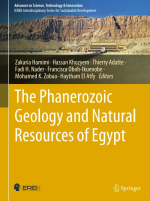Добрый день, Коллеги. Важное сообщение, просьба принять участие. Музей Ферсмана ищет помощь для реставрационных работ в помещении. Подробности по ссылке
The phanerozoic geology and natural resources of Egypt / Геология фанерозоя и природные ресурсы Египта
Egypt is located in northeastern portion of Africa and extends into the Asian near East. It is susceptible to many local and global tectonic events with sea-level changes during deposition of the Phanerozoic sediments. The Paleozoic history of Egypt showed that the sediments were meagerly comparing with the Mesozoic and Cenozoic. The most important structures which had a great effect on the stratigraphy of Egypt stretched from the northern shores of Egypt to its extreme southern part. The controlling factor in the development and distribution of the Paleozoic is rolled by several high arcs which stretch from south to north, irregularity with Pre-Cambrian and Paleozoic plumes (541–431 ± 20–30 Ma). Important glaciation sediments were recorded during the infra-Cambrian of the Hammamat sediments and Late Ordovician–Early Silurian Gabgaba Formation at southeast Egypt and Al Gilf Kebir which stretching from the northwestern part of Africa to the Arabian Plate. The Mesozoic deposits in Egypt are very unequally distributed. Marine Triassic is only known from the Arif El Naga dome in northeast Sinai, where continental Triassic covers more areas in Egypt. Marine Jurassic deposits were recorded from the north and northeast Sinai as well as from the western side of the Gulf of Suez. The best and most complete section of the Jurassic is exposed at Gebel Maghara North Sinai. On the other hand, Jurassic fluvio-marine and fluviatile sections were mapped from the southern parts of the country as far as lat. 23° 30′ N. Subsurface marine and continental sequences were identified in the subsurface of the north Western Desert. The transition from Jurassic to Cretaceous history was marked by a major and widespread hiatus in Egypt due to Cimmerian Event. Cretaceous deposits are widely distributed on the surface andsubsurface covering about 40% of the total area of Egypt extending from north Sinai to the Egyptian–Sudanese border. Remarkable facies and thickness variations arenoted in Egypt. Where Egypt was covered by a thin blanket of Mesozoic sediments in paleo-high areas, thick sections were deposited in trough areas in-between the arcs. The Early Cenozoic marine transgression covered most of Egypt and even penetrated inside Sudan. The history of the Cenozoic in Egypt witnessed three major events named: (1) closure of the Neo-Tethys; (2) rifting of the Gulf of Suez associated with the gradual uplift of the Red Sea Basement Mountains; and (3) Messinian Crises leading to the desiccation of the Mediterranean. <...>




